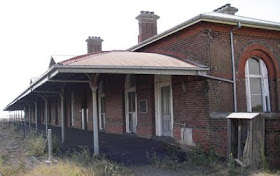After anticipating this milestone for a couple of years, the time has finally come -
The Horsham Times newspaper is now on the historic Australian Digitised Newspapers site.
More than six million historical Australian newspaper pages have been digitised, indexed and are now fully searchable on the National Library of Australia's TROVE site.
The aim of the Australian Newspaper Digitisation Program is to provide a range of metropolitan and regional newspapers from across Australia. The newspapers have to have been microfilmed, as it is the film which is digitised, and to have been originally published prior to 1955 (copyright provisions still exist for material published from 1955 onwards).
 |
| The 'Ararat Advertiser' undergoing quality assurance |
The process uses a master copy of the microfilm which is scanned by a contracting firm. Each newspaper page image is then quality assured by real humans (a time consuming and repetitive operation) and then sent to an OCR Optical Character Recognition contractor, this is the action which makes the image content searchable, and truly useful.
Major newspapers have been available for some time, and checking The Argus has found a whole range of local information which made the national news, but now with The Times so much more is available. The digitised copies cover the period from Tuesday 17th January 1882 to Wednesday 30th December 1953.
 |
| The first digitised issue - Tuesday 17 January 1882 |
The front page on Friday 13th in 1950 has the library article - "Free Library To Open Soon The City Council hopes to be able to open the Horsham Free Library soon. At the council meeting on Tuesday night, Cr. T. Conroy reported that good progress was being made with the work at the library. It was hoped to have the library open soon. When asked by the Mayor (Cr. Bennett) for an opening date, Cr. Conroy said that he was unable to set a date."
This relates when the City Council took over the existing subscription library (free being the costs were to be financed from rate revenue and all residents could use the library), and closed the Mechanics Institute building for extensions and renovations.
This new resource is going to be a great boon to both family researchers and local historians. The Horsham Times section is at http://trove.nla.gov.au/ndp/del/title/225
Check it out for yourself
 |
| Front page, Friday 13 October 1950 |


































 Then in January this year, a major one hit the Wimmera and Dimboola. Hundreds of volunteers and 20,000 odd sandbags limited the inundation, but some homes and the weir suffered at the flood peak. A large amount of debris and tree limbs smashed into the weir and a section of the south bank of the river gave way, taking a large portion of the carpark with it.
Then in January this year, a major one hit the Wimmera and Dimboola. Hundreds of volunteers and 20,000 odd sandbags limited the inundation, but some homes and the weir suffered at the flood peak. A large amount of debris and tree limbs smashed into the weir and a section of the south bank of the river gave way, taking a large portion of the carpark with it.
 A temporary sandbag leeve has lifted the river level in Dimboola to allow investigative work by GWM Water consultants. GWM Water (as the owner) is in discussions with its insurers for funding for restoration works, and options to alleviate any possible future failings to the embankment.
A temporary sandbag leeve has lifted the river level in Dimboola to allow investigative work by GWM Water consultants. GWM Water (as the owner) is in discussions with its insurers for funding for restoration works, and options to alleviate any possible future failings to the embankment.




 An elevator at one end took wheat from railway trucks to ridge level where it was distributed by conveyor (there are a couple of conveyor shots in the set) along the length of the shed, creating a huge single mound of grain. Braced internal timber bulkheads on either side took the lateral thrust of the wheat, and conveyors at ground level outside the bulkheads took wheat back to the elevator for transport elsewhere.
An elevator at one end took wheat from railway trucks to ridge level where it was distributed by conveyor (there are a couple of conveyor shots in the set) along the length of the shed, creating a huge single mound of grain. Braced internal timber bulkheads on either side took the lateral thrust of the wheat, and conveyors at ground level outside the bulkheads took wheat back to the elevator for transport elsewhere.




 The Public Records Office has a number of permanent displays in different rooms - Indigenous Victorians - early interactions with the government, including the Peppers at Ebenezer; Early Melbourne - settlement by Batman & Fawkner, and the Burke & Wills expedition; Ned Kelly - original documents, extracts from "The story of the Kelly Gang" film and the Kelly family tree; Crime & criminals - gangsters Squizzy Taylor, and female prisoner mug shots;
Victorians at work & on holiday - posters and photographs from the 1930-1950s; Victorian buildings - a range of architectural plans of public buildings; and Victorian democracy -how the gold miners helped shape Victoria's government.
The Public Records Office has a number of permanent displays in different rooms - Indigenous Victorians - early interactions with the government, including the Peppers at Ebenezer; Early Melbourne - settlement by Batman & Fawkner, and the Burke & Wills expedition; Ned Kelly - original documents, extracts from "The story of the Kelly Gang" film and the Kelly family tree; Crime & criminals - gangsters Squizzy Taylor, and female prisoner mug shots;
Victorians at work & on holiday - posters and photographs from the 1930-1950s; Victorian buildings - a range of architectural plans of public buildings; and Victorian democracy -how the gold miners helped shape Victoria's government.
